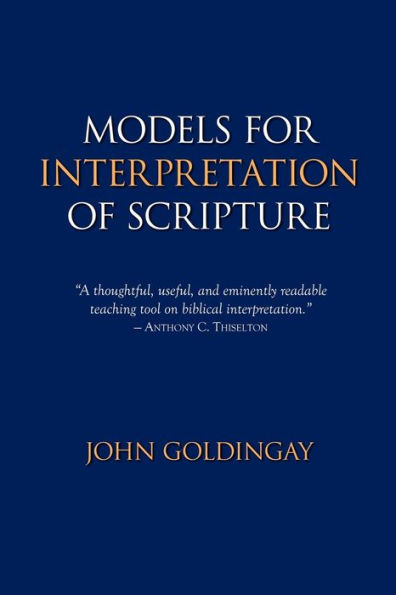

Paperback
-
PICK UP IN STORECheck Availability at Nearby Stores
Available within 2 business hours
Related collections and offers
Overview
JOHN GOLDINGAY is David Allan Hubbard Professor of Old Testament at Fuller Theological Seminary in Pasadena, California. He is the author of numerous scholarly books and commentaries on Daniel (Word Biblical Commentary) and Isaiah (New International Biblical Commentary). He has also written several more popular expositions such as After Eating the Apricot and Men Behaving Badly.

Product Details
| ISBN-13: | 9781894667401 |
|---|---|
| Publisher: | Piquant Publishing |
| Publication date: | 01/01/2004 |
| Pages: | 340 |
| Product dimensions: | 6.00(w) x 9.00(h) x 0.76(d) |
Table of Contents
- Introduction: Scripture's Varied Forms
- Witness in the Form of Story: Beginning from the Text
- Beginning from the Audience
- Scripture as Witness: Some Implications for Interpretation
- How Stories Preach
- Scripture as a Collection of Norms for Behavior
- Handling the Variety of Levels in Scripture
- Interpretation as a Feature of the Canonical Process
- The First Testament Prophets in the Second Testament
- The First Testament Prophets in the Modern World
- Interpreting a Historical Word
- Hearing the Words of God in the Words of Human Writers
- Interpreting a Revelation
- Interpreting Accounts of Human Experience
- The Corporateness of Scriptural Interpretation
- Subjectivity and Objectivity in Interpretation
- Reflective Expository Preaching
Approaches to the Interpretation of Scripture
Approaches to Preaching
PART I SCRIPTURE AS WITNESSING TRADITION: INTERPRETING NARRATIVE
History and Story
Focusing on the Story's Own Form and Structure
Looking for the Structures under the Surface of the Story
Deconstructing the Structures in the Story
The Story and Its External Referents
Authors and Audiences
The Audience Implied by the Story
The Role of Ambiguity and Openness in Stories
What We Bring to Stories
What We Read into Stories
Is It Audiences That Make Sense of Stories?
Why Is There Diversity in the Way People Understand Texts?
As Witness Scripture Points Us to God's Deeds More Than to Our Obligations
Witness to One Story: Implications in Terms of Typology
Witness to One Story: Implications for Liberation Hermeneutics
How Biblical Stories Preach
How Stories Engage Their Readers
Interpreting the Parables
The Parable of the Broadcaster
PART II SCRIPTURE AS AUTHORITATIVE CANON: INTERPRETING TORAH
The Meaning and Applicability of Scriptural Commands
The Diverse Perspectives and Levels of Scriptural Commands
Pointers from Jesus' Handling of the Torah
The Authority of Jesus and the Authority of the Torah
The Canon within the Canon
The Place of a Hermeneutic of Suspicion
Compromises in the Canon
Canonical Reapplication
Forms of Books
Complexes of Books
PART III SCRIPTURE AS INSPIRED WORD: INTERPRETING PROPHECY
Prophecy in Matthew 1-2
Matthew's Aims and Methods
Conscious and Unconscious Meanings
Traditional Figurative Interpretation
Contemporary Figurative Interpretation: Allegorical, Devotional, Liberationist, and Preterist-Millennialist
The Characteristics of Figurative Approaches
The Place of Historical Interpretation
The Process of Historical Interpretation
The Role and the Nature of Biblical Criticism
The Presuppositions of Tradition and of Criticism
The Risk, Promise, and Ultimate Aim of Historical Interpretation
Interpretation That Goes Deeper Than the Historical
Hearing the Word of God in the Words of Isaiah or Ezekiel
Critical Interpretation and Interpretation in Faith
PART IV SCRIPTURE AS EXPERIENCED REVELATION: INTERPRETING APOCALYPSE, TESTIMONY, AND THEOLOGICAL STATEMENT
Revelation and Myth
The Concepts of Myth and Demythologizing
The Complementarity of the Objective and the Self-Involving
How Such Interpretation Starts
How Such Interpretation Develops
Interpretation in the Context of an Interpretive Tradition
Interpretation in the Context of History
The Context of a Confessional Community
The Context of the Academic Community
The Context in Society
The Context of the Universal Church
The Universal Human Context
Exegesis and Appropriation
Exegesis and Application
Appropriation and Communication
The Complementarity of the Reflective and the Experiential
Discovering How the Text Addressed Its Hearers
Discovering How the Text Applies Today
How Expository Texts Communicate, and How We Communicate
Guidelines for the Expositor
Abbreviations
Bibliography
Index of Authors
Index of Scriptural and Other Ancient Jewish and Christian Writings
